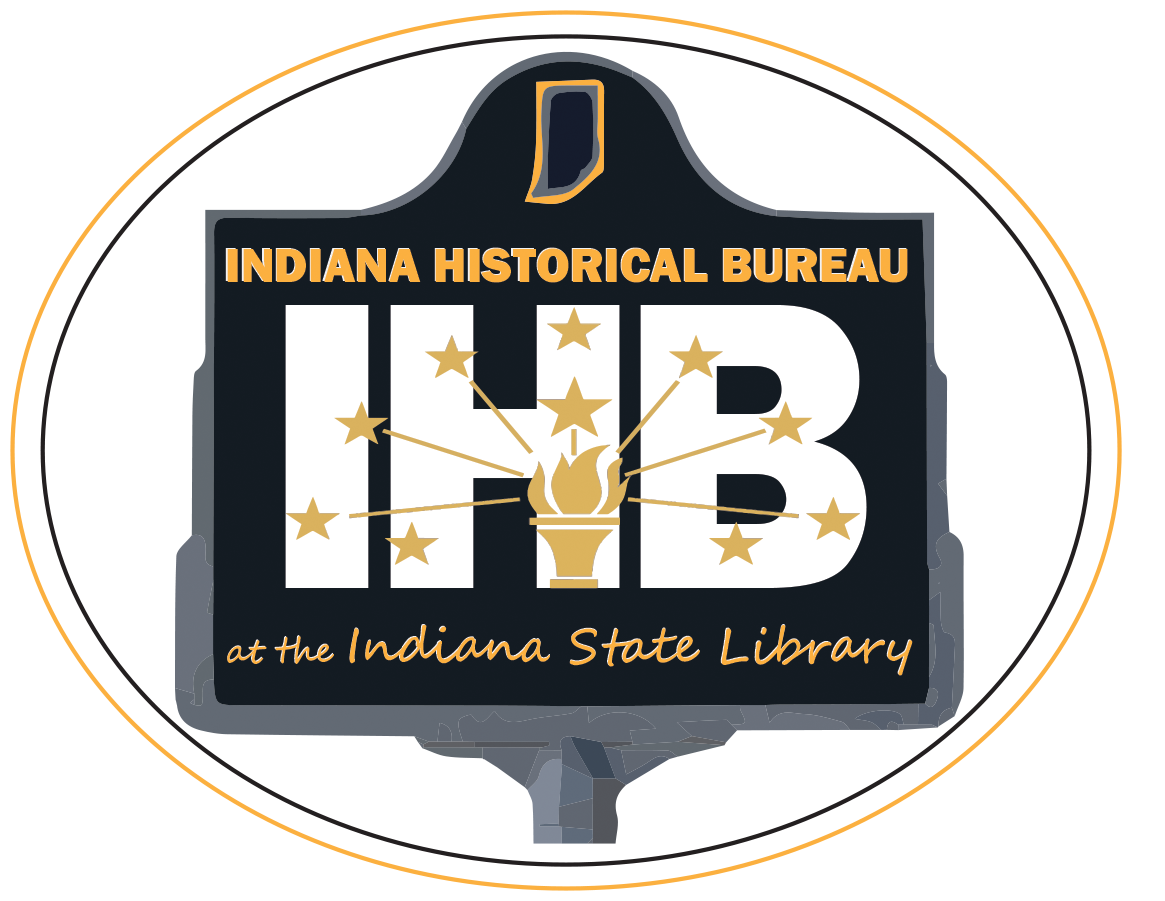Transcript for Episode 6 of the 2024 season of Talking Hoosier History.
On May 27, 1904, Chinese immigrants Moy Kee and Chin Fung prepared for a visit from royalty. They labored the entire night prior, prepping food, cleaning, and carefully decorating their Chinese restaurant located on Washington Street in Indianapolis. At 1 o’clock, their guests arrived. Indianapolis Mayor John Holtzman, business tycoon and future senator William Fortune, and the revered poet James Whitcomb Riley, attended the lunch party. However, the sizeable crowd assembled outside the restaurant wasn’t interested in this line-up of veritable Hoosier royalty. Instead, they showed up to see the rumored heir to the Qing Dynasty’s imperial throne, Chinese Prince Pu Lun.
Once gathered, the esteemed guests witnessed the fruits of Moy and Chin’s late-night labor. Outside of the restaurant, traditional Chinese lamps hung with brightly colored ribbons, with the American and Chinese flags flapping in the wind, side by side. The Indianapolis News described the interior of the building:
Oriental rugs were spread from the street to a teakwood table, where were placed two beautiful inlaid chairs covered with crimson satin draperies. The carved table stood on beautiful rugs, and upon it were placed burning incense, chop suey, and Chinese wine.
The lunch itself represented a unique fusion of Chinese and American culture. The first course consisted of Moy’s signature chop suey— a stir-fried dish with meat, vegetables, and sauce— paired with American beer. Ice cream and tea appeared for the second course, and the luncheon ended with traditional Chinese wine.
Upon departing, Prince Pu Lun presented the Moy family with a silk scarf and informed Moy that he would elevate him to Mandarin of the Fifth Rank, a prestigious Chinese status that would allow Moy to entertain and be entertained by royalty, wear special regalia, and hold a certificate denoting his prestige. This honor was monumental for a Chinese immigrant like Moy and a status that many of the wealthiest men in China failed to achieve.
But how did Moy Kee, an immigrant from the Guangdong Province, end up hosting Chinese royalty? How did he gain so much influence in Indianapolis during the height of Chinese exclusion and Sinophobia? The story is a fascinating one that raises an even deeper questions that the United States still wrestles with today: what does it mean to be an American citizen? And who gets to be a citizen and who doesn’t?
I’m Justin Clark and this is Talking Hoosier History.
Moy Kee immigrated to the United States in the 1850s as a young boy. Despite the stereotype of Chinese immigrants as “sojourners,” a caricature that described Chinese people as ephemeral immigrants who were not interested in settling down or learning American customs, Moy wanted to make the U.S. his permanent home. He learned English and converted to Methodism. Moy originally lived in San Francisco before moving to New York and later Chicago, where he began his protracted battle for American citizenship. Moy argued to the Chicago courts that because he began the naturalization process before the passage of the 1882 Chinese Exclusion Act—a restrictive federal law that banned the immigration of all Chinese laborers to the U.S.— that the law did not apply to him, and he was eligible for citizenship. Year after year the Chicago courts rejected his argument and Moy remained, legally at least, a stranger in his own home.
Moy’s legal luck changed in 1897 when he and his wife, Chin Fung, moved to Indianapolis, setting up Indiana’s proverbial “Hoosier Hospitality” for a litmus test. In Moy’s case at least, Hoosier Hospitality rang true and on October 18th, 1897, eighteen years after Moy began the naturalization process, the Marion County Court granted him his coveted citizenship. He and Chin settled down in Indianapolis, eventually opening a Chop Suey and Chinese Restaurant at 506 East Washington Street.
While Moy may have obtained his citizenship, his work to be accepted by his Indianapolis neighbors was far from complete. He sought to gain prominence in the community by providing quotes for the newspapers, throwing elaborate Chinese New Year’s Parties, and inviting local politicians to dine at his restaurant, among other numerous endeavors. Entrepreneurial and outgoing, Moy’s actions served to further integrate himself in Indianapolis by leaning on his Chinese roots. In turn, his newfound social status helped partially insulate Moy and other Chinese Hoosiers from the rampant Chinese discrimination and prejudice in America.
That same year, Moy and Americans across the nation were shocked by the traditionally isolationist Qing dynasty’s decision to participate in the St. Louis World Fair. Prince Pu Lun, the emperor’s nephew, was appointed as the Chinese fair commissioner and announced that, in addition to attending the fair, he would embark on a tour of the United States. Fortuitous for Moy, the tour included a ten-day tour of the Hoosier State.
Prince Pu Lun arrived at Union Station in Indianapolis on May 18, 1904. His schedule moved at a breakneck pace. Some highlights of the visit include the prince visiting the Columbia Club, touring Purdue University, and attending a commencement at May Wright Sewall’s Classical School for Girls. Moy met Pu Lun upon his arrival and again later at a Local Council of Women’s reception, during which Moy received a short audience with the Prince. Moy then lobbied for the opportunity to host Prince Pu Lun one last time before his departure. William Fortune vouched for Moy’s character to the prince and, upon hearing this, Pu Lun agreed to lunch with the Moy family at his restaurant.
The lunch was brief but pleasant and provided Moy with a critical opportunity to leave a lasting impression on Prince Pu Lun and his Hoosier hosts. When the Prince recommended Moy Kee for the fifth rank, Moy seemed genuinely surprised and delighted. After exchanging gifts and pleasantries, Prince Pu Lun departed the restaurant. He climbed the Soldiers and Sailors monument and said his goodbyes to his hosts before departing for Buffalo, New York to continue his tour.
In late July, Moy received a certificate from the Qing dynasty appointing him as the “mayor” of Indianapolis’s Chinatown. While this was an unofficial title, the Chinese government often named a prominent leader of an immigrant community as the mayor. For Moy, the title “Mayor” recognized his leadership within the American community, while the fifth rank designation solidified his significance within Chinese society.
Moy leveraged this new title to achieve national status. In 1906, Moy Kee traveled to Washington, D.C. where he met with Indiana Senator Charles Fairbanks and President Theodore Roosevelt. While he was tight-lipped about what he discussed with the president, newspapers speculated that he was lobbying for the repeal of the Chinese Exclusion Act. While unsuccessful, Moy described his visit with the president positively and a year later received an autographed postcard from Roosevelt.
Despite his prominent rise, the Moy family experienced several hardships. In October of 1907, the Qing dynasty stripped Moy of his Fifth Rank status and title as Mayor. The succinct letter refused to elaborate on why they revoked his status, and Moy couldn’t appeal the decision. In 1909, upon returning from a trip to visit family in China, Moy and Chin were detained at port in Tacoma, Washington. Immigration officials believed Moy’s citizenship papers were falsified. The couple were fortunately released but the month they spent in detention was a bleak reminder of the anti-Chinese sentiment across America. In 1911, the U.S. government filed a petition asking for Moy’s citizenship to be revoked on the basis that his naturalization had been incorrectly awarded 14 years prior.
According to the Indianapolis Star when Moy heard this news in his restaurant, he:
Dropped a dish which he had had in his hand and stared for several moments in silence. A look of anguish clouded his customarily smiling countenance. It was one of the saddest moments of his life. It was with difficulty that he spoke. ‘It’s no use to buck Uncle Sam… I’ll not fight it. If they don’t want me to be an American… it’s no use to fight them- I haven’t enough money to do that, even if I wanted to. It’s too bad.’ Then Moy fell silent. He would say no more.
Despite his previously dogged vigor and determination, Moy Kee, now in his early 60s, saw his fight for citizenship as a fading one. Nevertheless, the Indianapolis community rallied around the Chinese resident. Mayor Samuel L. Shank even wrote a letter to President Taft imploring him to allow Moy to retain his citizenship, calling him one of Indianapolis’s finest citizens. The letter fell on deaf ears and on October 9, 1911, Moy lost his beloved American citizenship.
Fortunately, Moy was not deported by the federal government and was allowed to live and work in Indianapolis. He continued to operate his restaurant and remained a cornerstone of Indy’s Chinese community. Newspapers noted that Moy still viewed himself as an American and, outside his restaurant, he still flew both a Chinese and an American flag.
In January of 1914, while eating dinner, Moy Kee suffered a sudden heart attack and died on the floor of his Washington Street restaurant, the same place where he had hosted Prince Pu Lun seven years earlier. The Indianapolis Star’s obituary for Moy noted his economic acumen and recognized their close working relationship, writing: “He was regarded as the prominent local source of information on questions relating to Chinese affairs and often was consulted by officials and newspaper writers of the city, among whom he had many friends.”
While it is key for historians to acknowledge and examine racial prejudices and discrimination against immigrant communities, it is also important to recognize those same immigrants’ resilience and success in the face of stacked odds. A keen entrepreneur, Moy was one of the first Chinese immigrants to settle in Indianapolis and served as a key cultural emissary, exposing Hoosiers to the customs, culture, dress, and cuisine of China. His life challenges numerous stereotypes about Chinese people and, by fighting for citizenship, he put forth a compelling argument that Chinese immigrants were just as worthy of American citizenship as any other ethnic group. As America continues to confront its tragic past and conflicted present regarding its treatment of Asian Americans and immigrants as whole, the story of Midwestern Chinese immigrants who fought for their rights serves as a powerful warning against xenophobia. Despite national exclusion and discrimination, Chinese immigrants like Moy remained resilient and utilized what agency they had to challenge narrow definitions of American citizenship and identity. While Moy died without exclusion being repealed, his and other immigrant’s activism set the base for future Asian American immigration and activism.
Want to learn more about Chinese immigration in Indianapolis? Check out our blog post “Cultural Emissaries: Chinese Immigration to Indianapolis” by IHB historian Kelsey Green.
IHB currently does not have any markers related to Chinese or Asian immigration. If you know of a historical topic connected to Asian history in Indiana that demonstrates statewide or national significance, please apply for a State Historical Marker! In the meantime, check out some of our other markers on immigration. The Hungarian Community marker in Terre Haute explores the thriving community of immigrants there who worked for coal mines, railroads, and manufacturing. They also fought for citizenship during World War I when anti-Hungarian sentiment was at an all-time high. Additionally, the Syrian Quarter marker in Indianapolis commemorates the history and contributions of Syrian immigrants who built a vibrant community at the present site of Lucas Oil Stadium.
We hope you liked this episode of the podcast. Let us know! Subscribe, rate, and review us wherever you get your podcasts. Once again, I’m Justin Clark, and this has been Talking Hoosier History. Thanks for listening.
This episode of Talking Hoosier History is voiced by Justin Clark, written by Kelsey Green, and produced by A.J. Chrapliwy.


